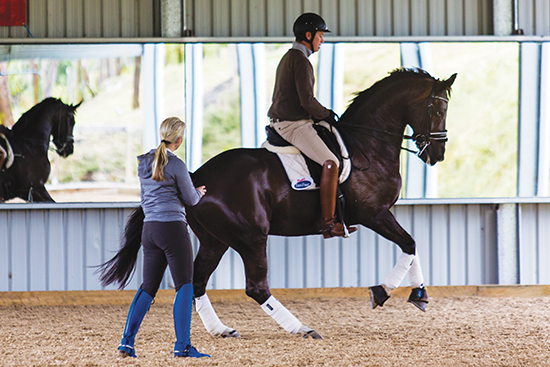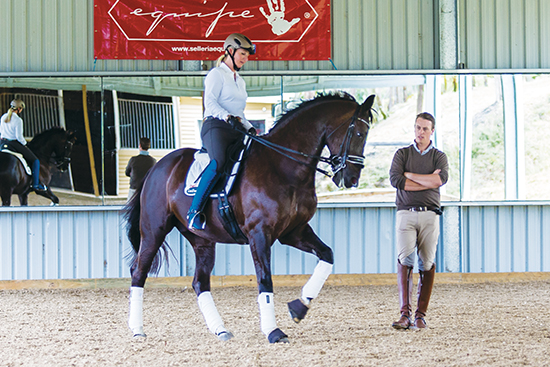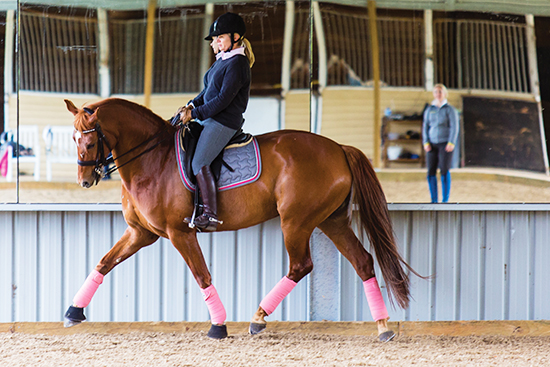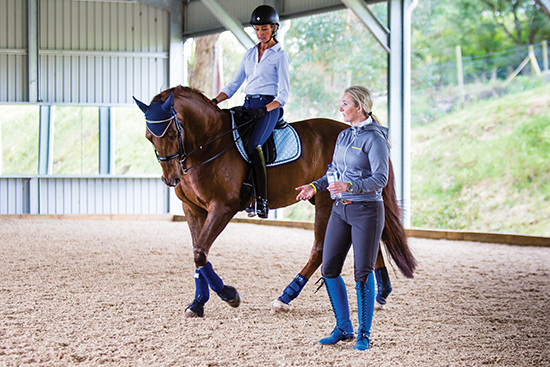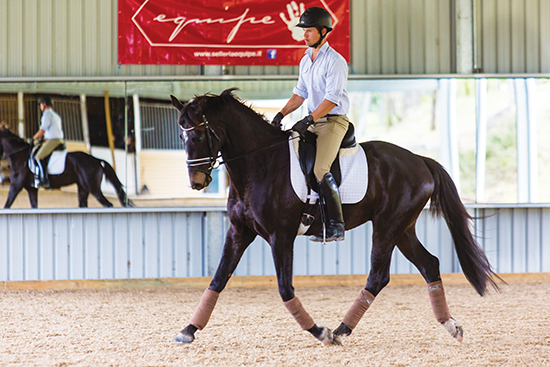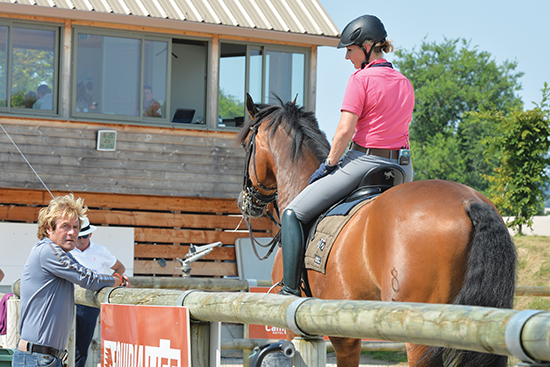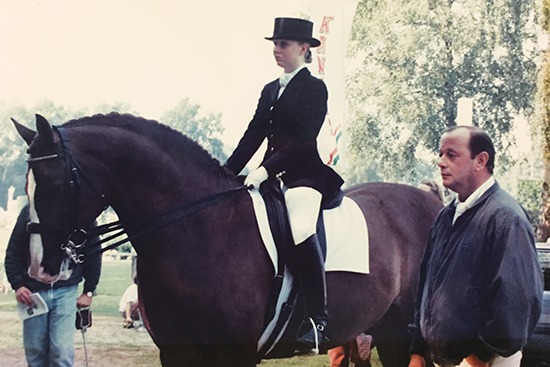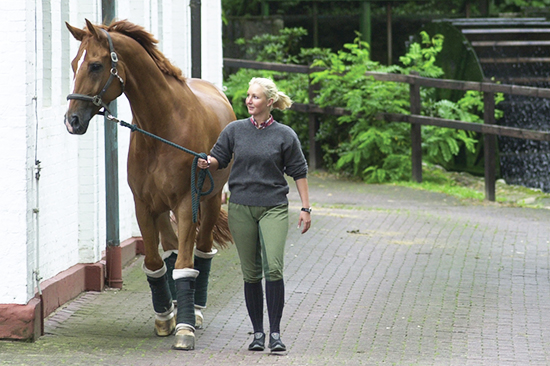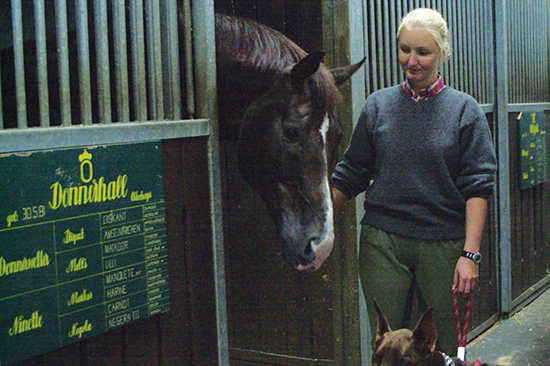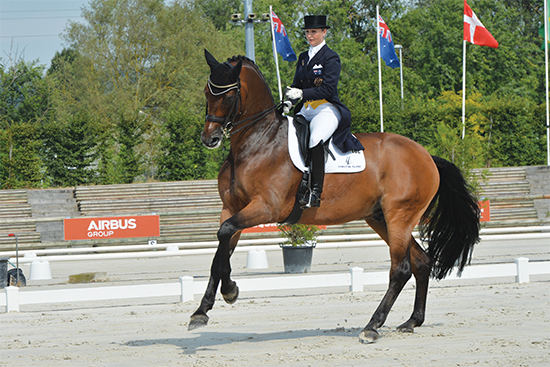 Story by Rebecca Ashton & Photos by Rebecca Ashton and Roz Neave
Story by Rebecca Ashton & Photos by Rebecca Ashton and Roz Neave
Kristy Oatley is giving a clinic at David and Amanda Shoobridge’s Revelwood Stud. It’s quite a family gathering at Revelwood, with one of Kristy’s sons, Oskar helping to build a quad bike, daughter Rosie is having a ride on a resident pony and other son Ben is talking to grandad ‘Cranky’, Kristy’s father Reiner Nist, and sister Susannah, who also have come up to visit. Kristy may have spent more than half of her life in Germany, but the dressage star and her family are still very much at home in Australia.
Kristy is watching David on his imported Agent de Jeu, a son of one of the stud’s resident stallions, 00 Seven, when I arrive, and interrupts the lesson to warmly welcome me. Her accent is still strongly Australian and it seems like she’s never left our shores. Then you see her teach, and her sharp eye from years of training with the best that Germany has to offer, with a touch of the more modern Dutch, thanks to her current trainer Sjef Janssen and you realise the great store of knowledge this young rider has gathered over the last 20 years abroad.
Kristy working with David and Agent de Jeu, a 00 Seven son
“Quicker behind! Not in front, just behind. Do a pony trot to get the control first then you can get your big trot back once he’s through. He needs to be quicker behind but still wait for you. When he takes that big leap, it’s because he’s speeding up in front. Keep it small first to get the hind legs faster.
“In that transition to canter, he sat back a little bit too much. He sits easily. You almost need to get the front end down a bit. You can get after him, but in a positive way,” instructs Kristy.
Then it’s on to working pirouettes. First Kristy wants perfect control of the horse’s bend and speed on a 15 metre circle before asking for a little shoulder in. Only then does she ask for a little bit from the hindquarters. One step at a time makes it easier for the horse to understand.
Kristy then changes into her fabulous blue Kempken boots before jumping aboard and making a few adjustments. “I need the stirrups shorter. Sjef has got me riding much shorter.” She gets Agent super soft into the contact, sharp off the leg, insists on good lateral bend and having the horse nicely filling out the outside rein, keeping him upright in the body and with a good connection. “This is the first time I’ve ridden in Australia in 14 years! I want to take this one home with me!” she enthuses.
There is no way David is going to finish the session without having a chance to feel the transformation in his horse and jumps on for a couple of rounds.
Emma and her Quando Quango daughter, Queenie
Emma Youngman is next on her imported mare Queensland, found by Kristy for her in Germany. “I rang Emma up and said there’s this Quando filly that isn’t too expensive and she bought her over the phone.”
“You learn to do what Kristy says”, laughs David
Queenie has the opposite issue to Agent in that she needs more encouragement to go forward.
“When you use your leg, she needs to go forward and not up. Don’t collect her for too long. Three strides then out or else she’ll start to prop. She has to go forward because you used your leg, not because you relaxed.”
“She’s doing Prix St Georges, so the counter canter isn’t helping to improve the canter. That’s fine with a young horse learning, but she needs to learn the quickness.”
“There she came back by herself without you telling her to. She’s not allowed to do that. If she learns to keep the forward by herself, her self-carriage will improve. You want a quick canter going into collection or else she’ll slow down.”
“She has to go through the corner a bit quicker. If she comes out of the corner slow, her first movement will be slow. I spent six weeks racing around the arena and corners with Ronan.”
Emma wants to focus a little on the trot half passes as well and Kristy offers the following advice, “You need a positive reaction off your inside leg BEFORE the half pass then ride her forward. More forehand. To start with, I don’t mind if the quarters a tad trailing if it means you keep the rhythm. You won’t get her across with your outside hand, use your outside leg. Use it once harder rather than 20 taps. Also, it’s better to do 20 preparations a day than 20 half passes.”
Lucinda and her ex-eventer
Lucinda Brownjohn and her ex-eventer KS Falkrich II have just started Prix St Georges and the smart little chestnut is quite hot today. Kristy explains, “Don’t give him any chance to lose his rhythm. Don’t go too deep into the corners for now. Do things gently. Now you have a good tempo, you can work with the bend a little bit more. Don’t have him in a tight, little frame, instead get him looser. He gets uptight then you get uptight and hold. Let him go and play a bit.”
It is then time to try some changes and Falkrich keeps wanting to drift left on the change to the right. Kristy introduces a little exercise, “Do the change then straight away afterwards, change your line and ride to the right.” This works to keep the horse’s shoulder straight.
Lucinda too is asked to try some working pirouettes and after some clear instructions, does a super job, “Ride the forehand on the perimeter of the 10 metre circle. He falls in a bit when you freeze. Ride a half pass on the circle. You have to keep the shoulders to the outside so he has no chance to spin at all. You have to draw a clear picture in your mind to keep your lines. You don’t want him to just fall in with the hindquarters. Keep the shoulders leading. Don’t do too much with your body. Look towards his outside shoulder so you don’t fall in.”
Elliot and Revelwood Wynston
The clinic isn’t just for FEI horses. Elliot Patterson arrives with Lucinda’s four-year-old Revelwood Wynston (Wynton/Rhodium), who he’s been riding for a few months. What a well-behaved youngster this is – but despite no spooking, his tension has led to a head carriage which is a little too high.
“The more things you give him to do, the more he’ll have his mind with you. The main thing with the young ones is that the transitions are very simple and very forward, with the aim that you have more ground coverage not faster. Even the downward transitions, there needs to be some forward. Have him following from front to back so you don’t lose the quarters in the transitions. Do them very gradually. Hold him a little with the contact, wait for him to give and take the bit forward then do the transition. Just play with the speed, which is what you need later in the training anyway.”
“It’s hand or leg, not both together. Like riding a bike, you can’t brake and pedal at the same time. Use your leg as an impulse. Tap, don’t squeeze and don’t let him do the transitions himself, especially with the hot ones or else they’ll run on adrenaline, not your aids,” says Kristy.
The horse’s frame slowly lengthens as he relaxes into the work but Elliot has to watch his position a little, “If you lean forward, it’s easier for him to stall, so stay tall.”
Like all trainers who get fully absorbed in their work, Kristy is late for lunch, but is still gracious enough to sit down for a chat…
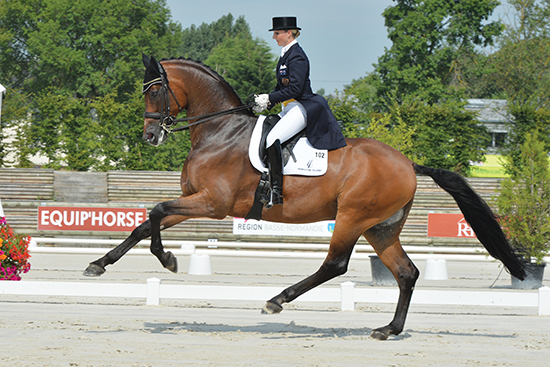 You never get tired of looking at the stunning Ronan
You never get tired of looking at the stunning Ronan
You’ve done all the big comps now a few times over. What keeps you going? Where does your drive to keep on competing come from?
Since WEG I’ve had about one or two weekends off and I’ve had a show every other weekend. Normally I’m like the less shows we do the better and I like to stay home, but also after getting the new horse (Du Soleil), I want to get out there a little bit more. I’ve got some good young horses coming up as well.
At the moment I’m really let’s ride, let’s compete, let’s go out. I don’t know why. It’s easier now that the kids are older (five, seven and nine). When they were smaller, I wanted to stay home with them and not be away too often.
Usually how old are your horses when you get them?
Every horse I have now, apart from Du Soleil, I either bred or bought as a two or three year old. I get someone to break them in, then we bring them back and my rider will ride them and then they go out into the paddock. They come back again for a couple of months, then back out and basically we’ll start to work them at the end of four years old. It’s a little bit different if you have a breeding stallion because the poor things have to stay in work and they have to do the stallion testing and all that and then they need to be out there in the public eye to get their service fees. I used to do all that but I prefer not to anymore. Usually I’ll start to ride them when they’re five or six.
How many horses have you got now?
I have Ronan, Du Soleil, Swagman, Louisa and Qualia. Qualia is a nine year old licenced stallion who is just starting Grand Prix and has done some Inter IIs. I still have Don Bolero who is now 20. He was breeding until recently and I still own Quando Quando who is over here in Australia. He’s just out there in the paddock.
Are all your riding horses in The Netherlands?
No, they’re all home with me near Hamburg and then I travel to Holland once or twice a month for a week at a time. Then we all go home again.
Kristy and her current trainer Sjef Jannsen
Why did you choose Sjef Janssen as a trainer?
Um…I think because my respect for him was extremely high. And, to put it bluntly, I was scared of him!! Haha. You know, I had always seen him at shows and I was just fascinated by him. Seriously, I was just absolutely fascinated and I saw that Anky rode in a way that just got absolutely everything out of every horse. I didn’t know Sjef on a personal level. I’d see him at shows and would say hello, but that was all. I had watched a lot of the German trainers train before and I’d been around them over the years when they would come and train with Mr Rehbein at Grönwohldhof, so I sort of knew everyone. I needed something new. I needed a new boost and a new kick and Sjef was the one I rang up and asked.
I started training with him October 2010 and the conversation started in July. I rang him up and asked if I could come and train and he said he didn’t have time. Always no, no, no but I kept ringing, I was persistent and he said ok you can come and we will try it out. Just one test run to see if we would get along with each other.
I went there for a week and took two horses. The first day I rode by myself and he watched and saw how I did things and at the end of it he told me what he thought. The next day we went right back to scratch and started from the beginning and I did a year-and-a-half of walk, trot and canter. He changed me. What I thought was black, he said was white, right from the start.
He was very, “This is how it is done” and was very consequent with what he said and was very strict, but I like that anyway. I’m not one to talk back or say anything when I’m riding. I listen and I do what I’m told. He explains everything so well that you don’t have to stop and say, “I don’t get what you mean.” He explains it to you in a way that you understand straight away what he wants. If I can actually do it is another question!
Way back, Kristy and one of the greats, Herbert Rehbein
That was also the first time I had ever had a training headset in my ear. I’d never used one of those before and of course I rocked up and he asked if I had an earpiece and I said no. I was used to something different with my lessons with Mrs Rehbein and all of a sudden I have Sjef in my ear and he’s talking to me non-stop. It was a really different feeling. It almost took me back to how it was with Mr Rehbein. Almost. Even though it was a different type of training system, Sjef could see what I felt. He could see it before I actually did it. THAT’S the thing that got me. That he was right… every single time. That’s what amazes me with him as a trainer. He’s right every single time and he can see what I feel on the horse, every, single, little thing. For me that’s just amazing.
That’s probably motivated you even more, I suspect…
Well it has. And you know you’re in that riding hall with Anky riding around on Salinero, Adelinde’s coming to train and Danielle Heijkoop and now Matthias (Alexander-Rath) is there. You have all these amazing people coming to ride and it’s great; we have a great time. We all combine and compliment each other and it works really well.
So, right back to the beginning, how old were you when you arrived in Germany all those years ago?
I was 12, 13. It was 1991.
What was that like? Arriving in Germany and being on your own at that age in a foreign country?
I was on my own but not really. The first time I went over I was with Mum. That’s when we bought Oskar. After that I went over with my grandparents for four or six weeks and they stayed with me. The next time I stayed with one of the girls who worked at the stables. The next time I went I had a nanny/ babysitter/ school teacher all rolled into one and then I was there. I didn’t really think much about it. I just went over and rode and did my school work and didn’t really think much about the fact that I might be there for a long time. It wasn’t really planned out. The first time I went over when I was doing my school work, I didn’t go to a German school, I did it via correspondence from Australia. At the beginning it was sort of go over with Oskar, have a bit of training and see if he’s up there ready to go Grand Prix and then we’ll bring him home. But Oskar turned out to be a really super little horse and we thought we’d leave him in Germany and get a second horse to bring home. But that horse was a little bit difficult, not as easy to train and one thing led to another and it just kept on going.
Did you do a lot of training with Rosemarie Springer as well in the early days?
No. Rosemarie gave her clinic over here in Australia in 1990. We had already planned to go to Germany because Mum wanted to buy another young stallion because we had already imported Domherr. We were going to buy a breeding stallion which would be my future horse but Rosemarie said, “No, no no. Why do you want a young stallion? Kristy needs a school master.”
I had already competed Prix St George in Australia, we had wanted to combine it all into one…a school master and a stallion, but of course we couldn’t find one, so we opted for the young Prix St George horse, which was Oskar.
Rosemarie got me into Rehbeins. She rang them up, saying that she had this young girl who needed to come and train, Mr Rehbein was like, “This is not a kindergarten. I am not training a 12-year-old girl.”
Rosemarie insisted and I rocked up at Grönwohldhof with her and Mum. Pik Primaire came into the arena and Mr Rehbein just looked at me and said, “Get on.”
So my first ride at Grönwohldhof was on Pik Primaire! After that Mr Rehbein decided I could come.
At the beginning I had the one horse, but I would probably ride four to five horses a day and he would throw me up on all of his horses. I was learning all the Grand Prix movements on his horses and Mrs Rehbein’s Don Primero, and Donnerhall.
This might be a tough question with all the time you spent at Grönwohldhof, but what was the single best bit of advice you ever got from either Mr or Mrs Rehbein?
There are so many little things. I think Mr Rehbein was just very much, “Concentrate.” Concentrate and hands down, ride your corners and keep the horses really active. It’s too hard to pick out just one thing.
One of the small pieces that someone has said to me was after Mr Rehbein died and I was at the European (Young Rider) Championships. I was going into the individual final. Mrs Rehbein was there with me and I think it was only about six weeks after he had died. Dr Schulten Baumer came up to me and said, “Go around the outside and just do a big extended canter and a big extended trot and just really wake him up.” That was one of the things I remember because it was a one off. That I will never forget. It was so nice of him and then I went out and won gold!
At Grönwoldhof with Wallstreet
What’s a normal day for you?
Wake up, get the kids ready to go to school. Then either me or my husband take the kids to school and then I ride. As soon as I’ve finished riding it’s time to pick up all the kids and then there’s after school activities… soccer, tennis, ballet. Rosie rides almost every afternoon as well. Then it’s home, dinner and bed! I ride three to eight horses a day and I don’t have a nanny, so it’s pretty busy. I’m pretty tired by the end of the day!
So your daughter has picked up the horse bug?
Yes Rosie has her own little pony and rides five to six times a week. But her pony isn’t with my horses. My horses are 20 minutes away from home and her pony is at a riding school 400 metres up the road from us, so it’s great. She can get him ready by herself, tack him up and she has a group lesson with other kids every day.
The boys aren’t interested?
No, they don’t ride. They love the ball sports. My husband used to be a professional football player so he likes that. He encourages the soccer and I like tennis so I encourage that!
Your biggest influences, be it riding or life?
My mother and my grandfather. Most definitely.
And you come back to Australia a lot?
Once, twice a year. But of course I never come back to ride or give clinics. I help David (Shoobridge) a little bit when I’m back, but that’s really it. David’s been at me for a while to give a clinic but when I’m over here, I don’t really have the time. There’s always so much to do and so many people to see.
and with Donnerhall
You’ve given a few lessons now to the Aussie riders. Is there any standout issues or advice you keep repeating?
I’ve actually been really positively surprised. I’ve been teaching a great set of horses. They’ve all really been nice and everyone is really keen to learn and keen to hear what you have to say. I just hope that it makes sense to everyone. I’m trying to be as simple as possible. A couple of them are imported but most of them are Australian bred horses and the quality has improved tremendously.
You’ve changed a bit in terms of your relationship with the media. There was a time you probably didn’t engage the media so much…
I’m not one to go out and talk about myself! That was hard doing the Facebook stuff over WEG! The only reason I did all those Facebook entries was that I read my stars and they said, “You need to be more media present”. I hardly ever read my horoscope and I read it the one time and that’s what it said! Maybe it’s a sign! So I thought, oh why not!
And you are very superstitious (pipes up David from the kitchen)
Yes very!
What are your pre comp superstitious rituals? You must have some!
Ah…seriously, my plaits always have to have an even amount on the mane and then the forelock.
That’s because you’re a hackie at heart!
No…it’s just ridiculous!
So no lucky undies?
No nothing like that, but if the horses went well and I had a certain bra on or something, I’ll have to wear it in the competition. If it doesn’t go well, I think stuff this, and I have all clean gear and I wash everything and it doesn’t matter. Stupid things like that. It’s horrible. I went well in Deauville so I didn’t wash my stock before WEG! It plays on my mind if I don’t do it. I make it up as I go and it’s really bad and I’m trying to get myself out of it! It’s not good.
Have you ever done any sports psychology work?!
No….but I think I should! Haha.


